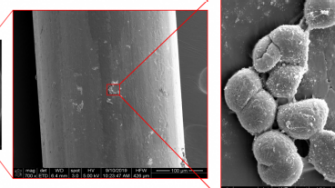
SOVS Paper of the Week: The aging of the population in many industrialised countries will result in an increased burden of aging-related ocular diseases, particularly age-related macular degeneration. Intravitreal injections are part of the treatment for this disease. A rare complication of this treatment is exogenous endophthalmitis, in which bacteria from the ocular surface are inadvertently introduced into the eye due to the injection. This infection has the potential to cause significant loss of sight.
Working with ophthalmologist’s Dr Jennifer Sandbach and Professor Minas Coroneo, the research involved collecting needles immediately following injection. The needles were then assessed for bacterial contamination using several approaches, 1) conventional culture, 2) 16S ribosomal(r) RNA gene sequencing which uses a DNA ‘signature’ present in bacteria to identify the bacterial community present on the needle surface, 3) confocal microscopy and fluorescent in situ hybridisation (which uses molecular markers to visualise the bacteria), and 4) scanning electron microscopy.
The result of the research show that despite the extensive sterilisation of the ocular surface with antiseptics and antibiotics prior to injection, bacteria could still be detected on the needle surface, with 16S rRNA gene sequencing identifying a greater diversity of bacteria compared to the traditional culturing approach. The bacterial microbiome detected on the needle surface was similar to that found on the ocular surface. Some of these bacteria could also be visualised adhering to the needle surface using the confocal and scanning electron microscopes.
The findings suggest that the risk of endophthalmitis remains even with sterilisation of the conjunctival surface.
See here for full link to paper: https://www.sciencedirect.com/science/article/abs/pii/S1542012420300884
